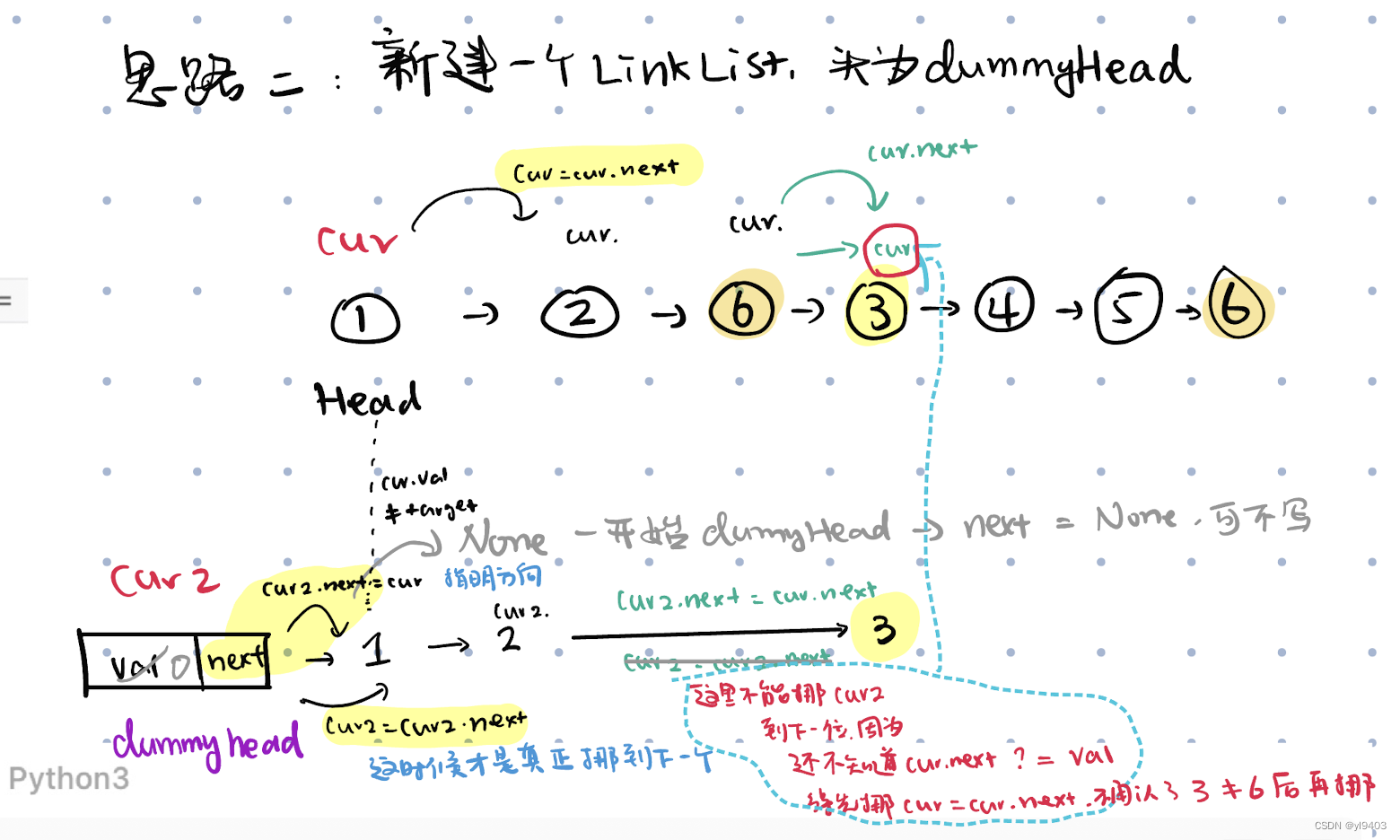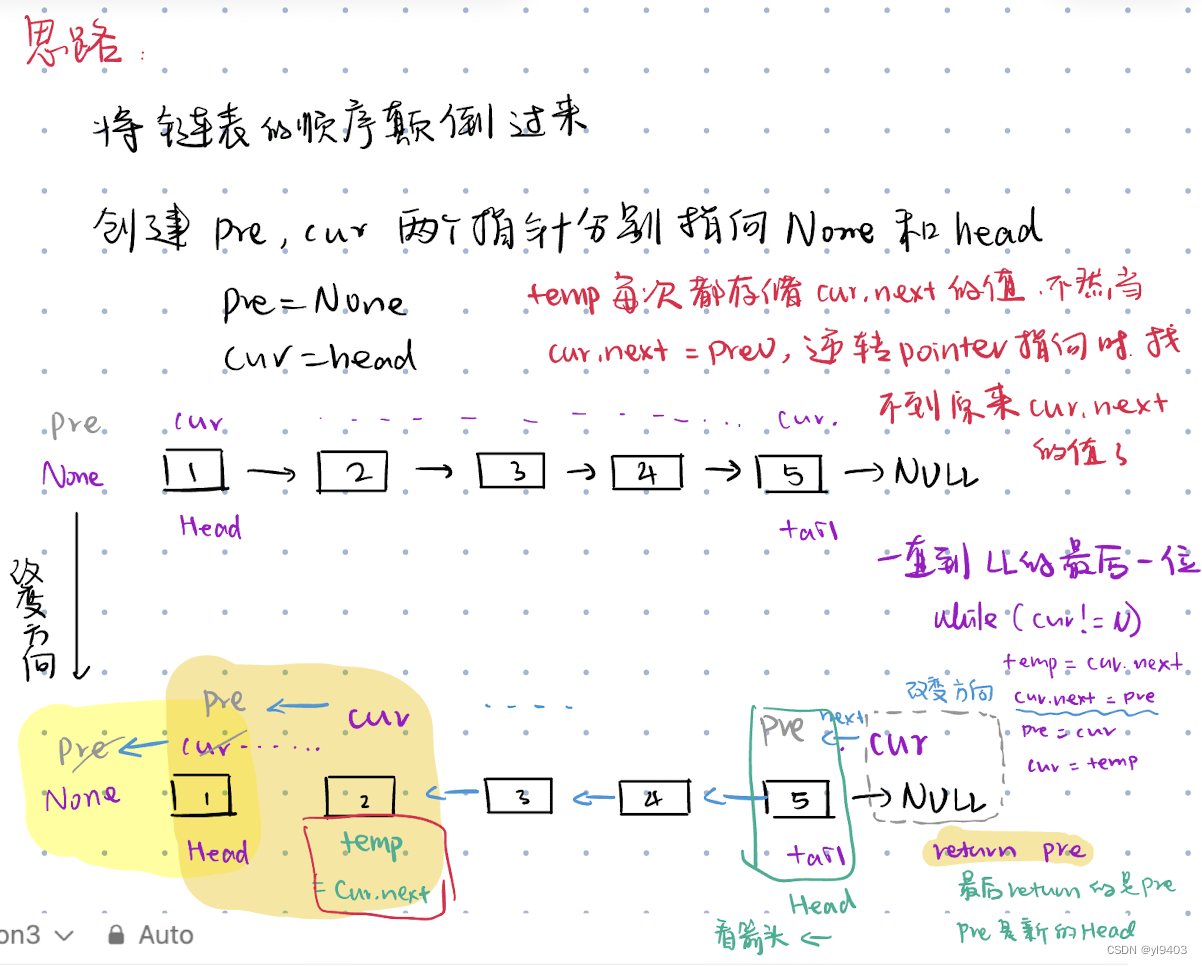203.移除链表元素
注意: 什么时候用while (cur != None), 什么时候用 while (cur.next != None)

# Definition for singly-linked list.
# class ListNode:
# def __init__(self, val=0, next=None):
# self.val = val
# self.next = next
class Solution:
def removeElements(self, head: Optional[ListNode], val: int) -> Optional[ListNode]:
dummy = ListNode(0, None)
cur = head # 原ll上的iterator
cur2 = dummy #新建的ll上的iterator, 从dummyHead开始
while cur:
# 如果cur.val == val的话, 就跳过这个node
if cur.val == val:
cur2.next = cur.next # 在新的ll中的cur2.next = cur.next
cur = cur.next # 原cur先挪下一个看是不是等于val
else:
cur2.next = cur # 这里cur2.next= cur 只是指明方向,并没有真的挪到下一个
cur = cur.next # cur向后挪一个,检查后一个是不是等于val的
cur2 = cur2.next # 这里才是真正让cur2挪位置
return dummy.next # return dummyhead的下一个, 因为下一个开始才是真正的LL
707. 设计链表
# 定义一个node: node 上有value和pointer next
class Node:
def __init__(self, val):
self.val = val
self.next = None
class MyLinkedList:
#定义LinkList: 有head和size
def __init__(self):
self.head = ListNode(0) # 定义一个dummyhead, head上的value默认是0
self.size = 0
def get(self, index: int) -> int:
if(index < 0) or (index >= self.size):
return -1
cur = self.head
for iter in range(index+1): #cur 从dummyhead开始,一直移动到idx = target index,
cur = cur.next
return cur.val
def addAtHead(self, val: int) -> None:
self.addAtIndex(0, val)
def addAtTail(self, val: int) -> None:
self.addAtIndex(self.size, val)
def addAtIndex(self, index: int, val: int) -> None:
if(index < 0) | (index > self.size):
return
cur = self.head
for iter in range(index):
cur = cur.next
newNode = ListNode(val)
newNode.next = cur.next # newNode插在cur的后面
cur.next = newNode
self.size += 1
def deleteAtIndex(self, index: int) -> None:
if index < 0 or index >= self.size:
return
cur = self.head #从dummyhead开始, 从dummyhead后面开始才是真正的idx 0,1,2 ....
for iter in range(index): # idx = 3,那就从dummy开始挪3位,dummy-> 0-> 1 -> 2
cur = cur.next # cur挪到index - 1的位置
cur.next = cur.next.next # 跳过index 那一个node
self.size -= 1
# Your MyLinkedList object will be instantiated and called as such:
# obj = MyLinkedList()
# param_1 = obj.get(index)
# obj.addAtHead(val)
# obj.addAtTail(val)
# obj.addAtIndex(index,val)
# obj.deleteAtIndex(index)206. 反转链表
注意: 设置temp先储存cur.next的值, 这样当cur.next = pre 改变原指针方向时就会找不到原来cur的下一个是什么

# Definition for singly-linked list.
# class ListNode:
# def __init__(self, val=0, next=None):
# self.val = val
# self.next = next
class Solution:
def reverseList(self, head: Optional[ListNode]) -> Optional[ListNode]:
cur = head
pre = None # pre 一开始为空, 因为我们要最后reverse过来的时候最后一个node连着的是空
while(cur is not None):
temp = cur.next #提前temp = cur的下一个, 这样当cur的next pointer指向pre的时候
cur.next = pre
pre = cur # 这样cur = 原来的cur.next
cur = temp
return pre




















 1013
1013

 被折叠的 条评论
为什么被折叠?
被折叠的 条评论
为什么被折叠?








